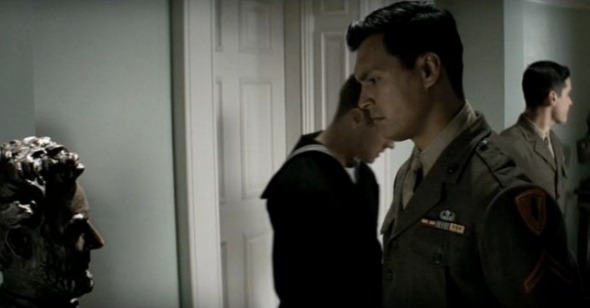Image Conscious
By Chris Wisniewski
Flags of Our Fathers
Dir. Clint Eastwood, U.S., Warner Bros.
Somehow, and I’m not entirely certain how, the releases of Mystic River and Million Dollar Baby definitively catapulted Clint Eastwood from a sensible level of respectability to the front line of contemporary American auteurs. Judging by Baby alone, it’s easy to see the artistic virtues behind Eastwood’s elevated reputation—a morally ambivalent but deeply sympathetic view of human nature, an arrestingly elegant patience and formal precision. That said, Mystic River is easily as uneven as Baby is accomplished—muddled, overwrought in a decidedly masculine way, and occasionally amateurish in execution (we can only hope those scenes of Kevin Bacon’s wife were shot by a second-unit director). Indeed, part of what makes Eastwood so difficult to assess is that his oeuvre—and almost every film within it (with the noteworthy exceptions of Million Dollar Baby and Unforgiven, each masterpieces of a sort)—is both remarkably impressive and inconsistent: a film like The Bridges of Madison County threatens at equal turns to devastate with its subtle power and to come crashing down with a thud (that he pulls it off at all is a remarkable feat, but every time those kids reappear, the whole thing teeters ever so precariously). Flags of Our Fathers follows in that tradition, but if it fails to live up to Eastwood’s inflated reputation, it’s actually a fine example of what makes him such a fascinating filmmaker.
Whatever expectations accompany Flags’s release, its opening moments, in which a frail-voiced Eastwood sings a brief song over the credits, should set aside considerations of Oscars, Golden Globes, and critics’ awards. There’s something personal and intimate about Eastwood opening the film this way that stands in stark contrast to the crass awards pandering we’ve come to expect from most American filmmakers at this time of year. Though a high-class, pedigree product (directed by an Oscar-winner, produced by Spielberg), Flags proves surprisingly ambivalent about its hallowed subject; it sets off to deconstruct the mythos of the “Greatest Generation,” not by way of attacking the reputation of the soldiers who fought in World War II but in revealing how their images have served to signify something, ideologically and morally, while stripping their human experience of its substance.
Flags follows three of the men (Adam Beach, Ryan Phillippe, and Jesse Bradford) who raised the American flag in the famous photograph taken at Iwo Jima, moving across three time periods, including the present day. This triptych illuminates the gulf between experience and memory and between memory and history, using its protagonists deliberately as symbols, showing how collective need and the sweep of history rendered the subtleties of their personalities and experiences irrelevant. Though the screenplay by William Broyles Jr. and Paul Haggis isn’t always up to the task, the very concept of the film demands a structural obliqueness. Relationships between characters are unclear, emotions distorted or ambiguous. The battle scenes feature a Private Ryan-esque subjectivity and immediacy, but for the most part, Eastwood holds us at arm’s length, clearly demarcating our own mediated position as spectators. Accordingly, the transitions between time periods are abrupt and disruptive—first we’re here, now there, now back here again—and Eastwood deliberately plays on our assumptions (what seem at first to be explosions are, in fact, fireworks). The only principal actor to bring more than a bland likeability to his role is Beach, but that’s probably due in part to his character’s more complicated position as both American hero and Native American Other, a man doubly burdened by the weight of competing stereotypes. The film actually works best when it avoids getting too close to the men; its most significant flaw lies in an overly personal and unearned present-day epilogue that provides too much resolution for a film built on an open-ended opacity.
Flags of our Fathers sometimes has the look and feel of something truly remarkable, a kind of pristine, nearly monochromatic austerity, which complements its iconoclasm. Yet whatever its accomplishments, the film seems to stumble over its own ambition. By design, it should defy conventional engagement and narrative satisfaction, but Eastwood, Haggis, and Broyles don’t seem content with their own dramaturgy. Their baser instincts get in the way, and as the film hurtles further away from Iwo Jima and the time period immediately following it, we’re left with too many moments that have the feel of those scenes with the kids in Bridges of Madison County or the stuff towards the end of Mystic River—an awkward strain so at odds with Eastwood’s strengths as an artist but so consistently present in his filmmaking that it’s easiest for his admirers to pretend it isn’t there. Whatever image of Eastwood each of us chooses to see, though, there can be no doubt of his singularity, and in that sense, Flags of our Fathers may be emblematic: a deconstruction of iconography made by an icon, a kind of meta-text for a filmmaker quite unlike any other, Flags of our Fathers may not be the best film released by an American studio this year, but it’s certainly one of the oddest—and most human.
